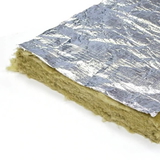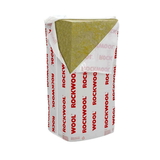- Blogs
- Rockwool Loose Fill Insulation: A Comprehensive Guide
Rockwool Loose Fill Insulation: A Comprehensive Guide

Rockwool Loose Fill Insulation, also known as blown-in insulation, is an efficient way to protect buildings and their occupants against fire, nuisance noise, and heat loss. It’s easy to install and ensures maximum performance.
What is Rockwool Loose Fill Insulation?
Unlike traditional insulation products such as rolls and slabs, Rockwool Loose Fill Insulation is blown into the applied area using a blowing machine. This method ensures maximum coverage with minimal effort, making it ideal for hard-to-reach places.
Why Choose Rockwool Loose Fill Insulation?
Rockwool loose-fill insulation is an efficient way to protect buildings and their occupants against fire, nuisance noise, and heat loss. It’s made from stone wool, which is known for its excellent thermal insulation properties, fire resistance, and sound absorption capabilities.
Rockwool Insulation
Easy Installation
One of the key advantages of Rockwool Loose Fill Insulation is its ease of installation. It is designed for fast and easy application, usually done by an approved installer. This makes it a practical choice for both new constructions and retrofitting older buildings.
Ensuring Maximum Performance
Rockwool Loose Fill Insulation ensures maximum performance by providing comprehensive coverage. It fills all gaps and irregular spaces, ensuring that no area is left uninsulated. This results in better temperature regulation, which can lead to lower energy bills and a more comfortable living or working environment.
Applications of Rockwool Loose Fill Insulation
Rockwool Loose Fill Insulation is a versatile product that can be used in a variety of settings to enhance the thermal and acoustic properties of a building. Here are some of its key applications:
-
Cavity Walls: In the context of cavity walls, Rockwool Loose Fill Insulation is installed between the outer and inner walls. This application is particularly beneficial in reducing heat loss through cavity spaces, which is a common issue in both renovated buildings and new builds. By filling these cavities, the insulation helps maintain a stable indoor temperature and reduces the need for excessive heating or cooling.
-
Loft Insulation: Rockwool loose-fill insulation is also used for loft insulation. It is blown in between and on top of floor joists in attic spaces. The purpose of this application is to prevent heat from escaping through the roof. As heat rises, uninsulated attics can be a significant source of energy loss. By insulating this area, homeowners can ensure a warmer house in the winter and a cooler house in the summer, leading to energy savings.
-
Timber Frame: Another application of Rockwool Loose Fill Insulation is in timber-framed structures. The insulation can be applied between timber studs in external walls. This not only provides higher levels of thermal insulation but also contributes to soundproofing the building. By reducing the effects of noise, occupants can enjoy a quieter and more comfortable living or working environment.
In summary, Rockwool Loose Fill Insulation is a practical and efficient solution for various insulation needs. Its easy application and versatile usage make it a popular choice for both residential and commercial buildings.
Installation of Rockwool Loose Fill Insulation
Installing Rockwool Loose Fill Insulation is a process that, while straightforward, requires precision and care to ensure optimal performance. Here’s what you need to know:
Professional Installation
While the process is simple, it’s recommended that a professional installer with the right equipment and expertise handle the job. This ensures that the insulation is applied correctly and safely.
The Right Tools for the Job
The key tool for installing Rockwool Loose Fill Insulation is a blowing machine. This specialised equipment allows for the insulation to be distributed evenly and efficiently, reaching every nook and cranny without the need for manual spreading.
Preparing the Space
Before installation, the area must be prepared. This includes ensuring that all electrical cables are safely out of the way and that any loft hatches are properly sealed to prevent the insulation from being disturbed.
The Blowing Process
Using the blowing machine, the installer will distribute the Rockwool granulation throughout the space. The machine’s flexible hose allows for targeted application, ensuring that the insulation fills the cavity walls, loft spaces, and timber frames effectively.
Ensuring Maximum Coverage
The goal is to achieve maximum coverage with minimal effort. The blowing machine’s precision allows for the insulation to be applied in a uniform layer, which is essential for preventing heat loss and ensuring the effectiveness of the insulation.
Post-Installation Checks
After installation, it’s important to conduct a thorough check to ensure that the insulation is evenly distributed and that there are no gaps or voids. This step is crucial for maintaining the integrity of the insulation’s thermal and acoustic performance.
The installation of Rockwool Loose Fill Insulation is a process that benefits greatly from the skill of a professional installer. With the right tools and techniques, your home can be insulated effectively, providing you with a comfortable and energy-efficient living space.
Benefits of Rockwool Loose Fill Insulation
Rockwool Loose Fill Insulation is a premium choice for those looking to enhance their home’s energy efficiency and comfort. Here’s an in-depth look at its advantages:
Energy Efficiency and Cost Savings
Rockwool insulation is renowned for its excellent thermal properties. It effectively prevents heat transfer, keeping your home warmer in winter and cooler in summer. This thermal regulation means that there’s less reliance on heating and cooling systems, leading to significant savings on energy bills.
Fire Resistance and Safety
Safety is a top priority, and Rockwool’s high melting point of 1,800-2,000 degrees Fahrenheit makes it an excellent fire retardant. In the event of a fire, it can help prevent the spread of flames, providing valuable time for occupants to evacuate.
Acoustic Comfort
Noise pollution can be a significant issue, especially in urban areas. Rockwool insulation has superb acoustic properties, reducing the noise from outside and contributing to a quieter, more peaceful home environment.
Moisture Management and Air Quality
Rockwool’s breathability is a key feature that contributes to a healthier home. It allows air and moisture to travel through, reducing the risk of dampness and mould growth, which can have adverse effects on air quality and health.
Environmental Impact
Choosing Rockwool Loose Fill Insulation is an environmentally responsible decision. It’s made from natural stone and is often composed of up to 90% recycled material, making it a sustainable option for eco-conscious homeowners.
Durability and Longevity
Rockwool insulation is not only effective but also durable. It maintains its shape and insulating properties over time, ensuring that your home remains insulated for years to come without the need for frequent replacements or upgrades.
Rockwool Loose Fill Insulation offers a comprehensive range of benefits that go beyond just energy savings. Its fire resistance, soundproofing qualities, and environmental sustainability make it an all-around excellent choice for any home. For further details and to ensure the best application for your specific needs, it’s advisable to consult with insulation professionals.
Conclusion
In summary, Rockwool Loose Fill Insulation emerges as a highly effective and versatile solution for enhancing building performance. Its unique properties, derived from stone wool, offer benefits ranging from energy efficiency and fire resistance to acoustic comfort and environmental sustainability.
The ease of professional installation and comprehensive coverage make it a practical choice for a variety of applications, ensuring long-term durability and contributing to a healthier, more comfortable living or working environment.
In selecting Rockwool Loose Fill Insulation, individuals prioritise not only energy savings but also safety, environmental responsibility, and lasting building integrity. Consulting with insulation professionals is advised to maximise the benefits tailored to specific needs.

Samuel Hitch
Managing Director
Buy Insulation Online.
Leave A Reply
Your feedback is greatly appreciated, please comment on our content below. Your email address will not be published. Required fields are marked *












































































































































































































































































































































































































































